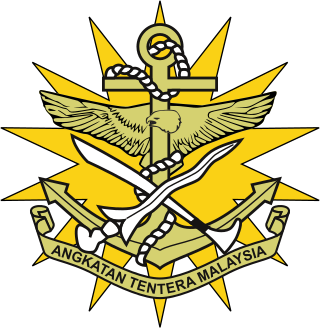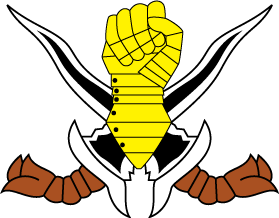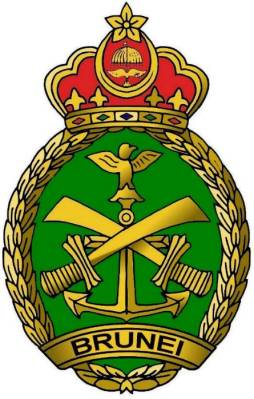
The Malaysian Armed Forces, are the armed forces of Malaysia, consists of three branches; the Malaysian Army, Royal Malaysian Navy and the Royal Malaysian Air Force. The number of MAF active personnel is 113,000 along with reserve forces at 51,600.

The Malayan Emergency, also known as the Anti–British National Liberation War, (1948–1960) was a guerrilla war fought in the Federation of Malaya between communist fighters of the Malayan National Liberation Army (MNLA) and the military forces of the Federation of Malaya, British Empire and Commonwealth. The communists fought to win independence for Malaya from the British Empire and to establish a communist state, while the Malayan Federation and Commonwealth forces fought to combat communism and protect British economic and colonial interests. The term "Emergency" was used by the British to characterise the conflict in order to avoid referring to it as a war, because London-based insurers would not pay out in instances of civil wars.

The Royal Malaysian Air Force was formed on 2 June 1958 as the Royal Federation of Malaya Air Force. However, its roots can be traced back to the Malayan Auxiliary Air Force formations of the British Royal Air Force in then-colonial British Malaya. The Royal Malaysian Air Force operates a mix of modern American, European and Russian-made aircraft.

The Malayan Communist Party (MCP), officially the Communist Party of Malaya (CPM), was a Marxist–Leninist and anti-imperialist communist party which was active in British Malaya and later, the modern states of Malaysia and Singapore from 1930 to 1989. It was responsible for the creation of both the Malayan Peoples' Anti-Japanese Army and the Malayan National Liberation Army.

The Malaysian Army is the land component of the Malaysian Armed Forces. Steeped in British Army traditions, the Malaysian Army does not carry the title ‘royal’ as do the Royal Malaysian Navy and the Royal Malaysian Air Force. Instead, the title is bestowed on selected army corps and regiments who have been accorded the honour by the Yang di-Pertuan Agong, who is the Supreme Commander of the Malaysian Armed Forces.

The Rejimen Askar Wataniah is the military reserve force of the Malaysian Army.

Royal Intelligence Corps is a Malaysian intelligence agency specialising in intelligence gathering, intelligence analysis, psychological warfare, surveillance, espionage, reconnaissance and counter-intelligence operations. It also manages the propaganda and counter-propaganda effort of the Malaysian Army.
The Federation Regiment was an attempt by British General Gerald Templer (1898–1979) to form a multiracial infantry regiment of the Malayan Federation Army.

The Kor Polis Tentera DiRaja is the military police branch of the Malaysian Army. Referred to as the "Redcaps" like their British counterpart or, more popularly, known as "MPs", the Kor Polis Tentera DiRaja keep discipline within the Army ranks and ensure security at Malaysian Army installations.

Gerak Khas (GK), or Grup Gerak Khas, (GGK) also spelled Gerakhas, is a Malaysian Army special forces (MASF) unit that performs special operations missions such as direct action, unconventional warfare, sabotage, counter-terrorism, and intelligence gathering. Gerak Khas was founded in 1965 during the Indonesia-Malaysia conflict, and they gained worldwide fame and recognition after successfully pacifying the communist insurgency in Malaysia's jungles between 1968 and 1989.

The Royal Armoured Corps or Kor Armor Diraja (KAD) is the armoured forces of the Malaysian Army.

The Malayan National Liberation Army (MNLA) was a Communist guerrilla army that fought for Malayan independence from the British Empire during the Malayan Emergency (1948–1960) and later fought against the Malaysian government in the Communist insurgency in Malaysia (1968–1989). Many MNLA fighters were former members of the Malayan Peoples' Anti-Japanese Army (MPAJA), including its leader Chin Peng.

The Communist insurgency in Malaysia, also known as the Second Malayan Emergency, was an armed conflict which occurred in Malaysia from 1968 to 1989, between the Malayan Communist Party (MCP) and Malaysian federal security forces.

The RMAF Special Forces, better known as PASKAU, is the special forces of the Royal Malaysian Air Force.

The Royal Brunei Armed Forces (RBAF); Malay: Angkatan Bersenjata Diraja Brunei (ABDB), Jawi: رايول بروناي آرميد فوس, is the official organisation and collective term for all of the military forces or service branches of the sultanate of Brunei Darussalam. The RBAF consists of three primary military branches; the Royal Brunei Land Force, the Royal Brunei Navy, and the Royal Brunei Air Force.

The Chief of the Defence Forces is the professional head of the Malaysian Armed Forces and the most senior uniformed military adviser to the Yang di-Pertuan Agong, the Prime Minister and the Minister of Defence. The CDF is based at Wisma Pertahanan, Kuala Lumpur, nearby to the Ministry of Defence. The CDF is the highest rank in Malaysia Armed Forces only after the YDPA which holds the title Commander-in-Chief.
The Special Forces and Elite Forces include both a specially and higher trained unit and a small percentage of personnel from a specific Malaysian military branch, law enforcement or government agency. In Malaysia, the term 'Special Forces' is widely used by uniformed services for special forces, special operations forces and 'special' trained units while 'Elite Forces' for units that more trained and capable combat. Regular personnel must undertake specialized and higher training to be able to join the units of the 'Special and Elite Forces'. These "Special Elite Forces" are denoted by different beret colours, shoulder tabs, unit patches, skill badges and uniforms.
The Special Forces Selection is the recruitment, selection, and training process for candidates of the Special forces units in Malaysia. This selection process is not limited only to the special forces of the Malaysian Armed Forces but also includes the Royal Malaysian Police, the Malaysian Coast Guard, and the Johor Military Forces, which is a private army of the state of Johor. Currently, there are four training centres, also known as commando schools, and one non-commando school in Malaysia that conduct special forces selection.
The Royal Malaysian Air Force Regiment is a ground-based formation that is part of the Royal Malaysian Air Force. It comprises units that serve as special forces, air force infantry, security forces, and ground combat instructors. The regiment's headquarters are located at RMAF Jugra Air Base in Banting, Selangor.
Royal Logistics Corps is an organization that responsible providing logistical support includes managing the supply chain, ensuring the availability of essential resources like food, water, fuel, ammunition and overseeing the transportation of personnel and equipment for Malaysian Armed Forces. The corps is also responsible for the maintenance and repair of military vehicles and equipment, delivering medical services, emergency care and providing administrative support. By fulfilling these critical functions, the Royal Logistics Corps enables the Malaysian Army to maintain its effectiveness and readiness for various operations and missions.















